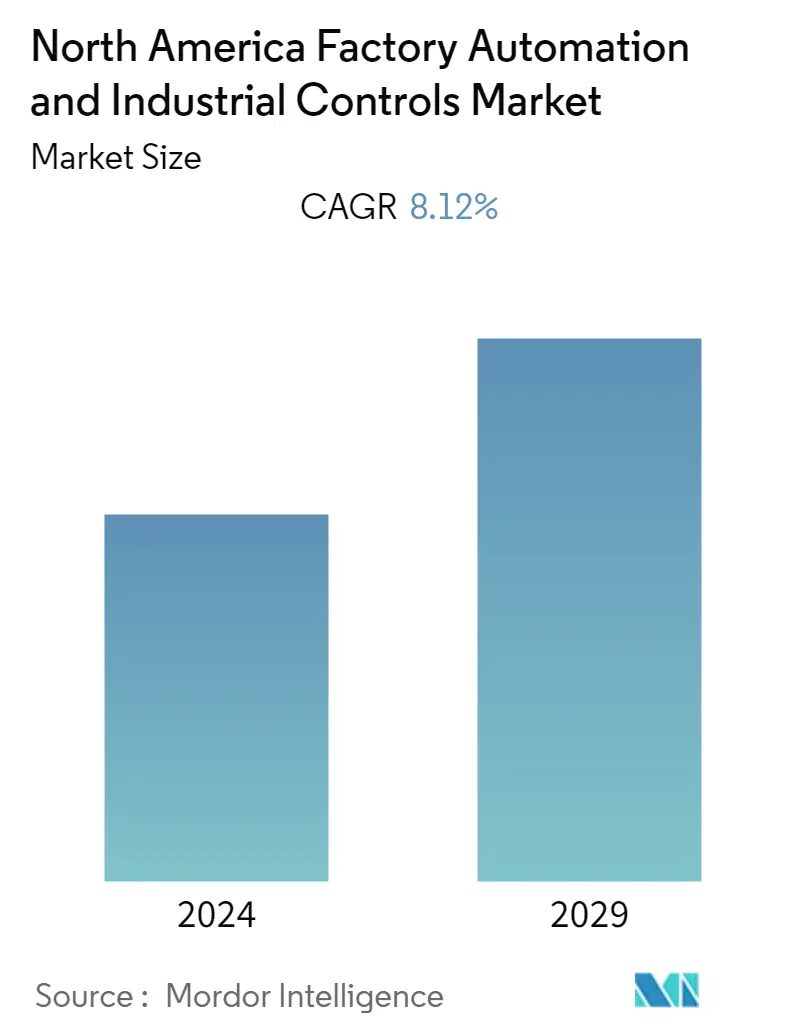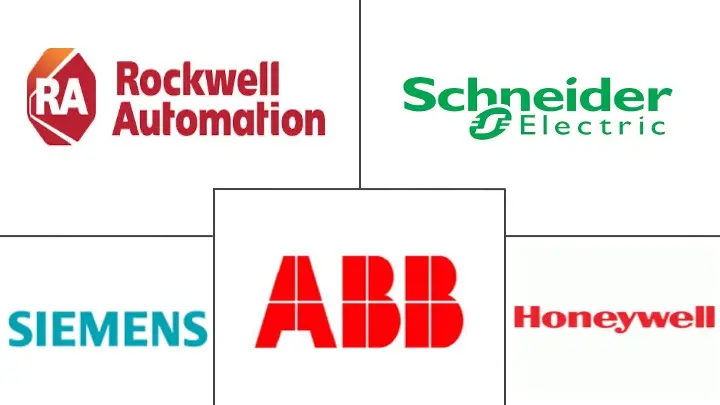Market Size of North America Factory Automation and Industrial Controls Industry

| Study Period | 2019 - 2029 |
| Base Year For Estimation | 2023 |
| Forecast Data Period | 2024 - 2029 |
| Historical Data Period | 2019 - 2022 |
| CAGR | 8.12 % |
| Market Concentration | Medium |
Major Players
*Disclaimer: Major Players sorted in no particular order |
North America Factory Automation and Industrial Controls Market Analysis
- The North America factory automation and industrial controls market is expected to register a CAGR of 8.12% during the forecast period (2021 - 2026). The growing incidents of coronavirus, are also forcing manufacturers to rely more on automation and digitalization for long-term operations to reduce the financial impact of epidemics and other potential economic challenges. Factories are reducing human interaction and installing device barriers between workers to protect them from infection, which is further expected to create a need for automated devices and systems. North American manufacturers across all industries are establishing the advancement foundation by increasingly enhancing their level of automation. In a race to be competitive with global manufacturing hubs, like China and Japan, North America still needs to be more aggressive in developing and adopting robotic and automation technologies.
- Therefore, to save energy and to gain cost-benefit, the trend of factory automation and industrial control systems is gaining traction in the region. According to a 2019 report from Oxford Economics, the United States is projected to lose more than 1.5 million jobs to automation over the next decade.The regional automotive sector has always led the way in implementing robotics in their manufacturing processes. Key industry manufacturers, like John Deere, are making significant investments to integrate automated technology both into their products and processes.
- The region is witnessing increasing robotic technologies adoption. For instance, in March 2020, globally renowned SCARA robot manufacturer, Epson Robots, collaborated with the US-based automation solutions provider, Air Automation Engineering (AAE), as part of an initiative to increase its technical support in the Midwest United States.
- The adoption of factory automation solutions can help these manufacturers in cost savings, enhance productivity, and improve quality. Recently, Royal Bank of Canada (RBC) collaborated with Microsoft and launched the Go Digital program, mainly to help the Canadian businesses in investing in smart automation technologies and cloud solutions. Presently, the program is available to Canadian food manufacturers and will continue to expand to other industries over time.
- Initiatives, like 'Advanced Manufacturing Partnership (AMP)', are increasingly undertaken to make the regional industry, various universities, and the federal government to invest in the emerging automation technologies. The government in Canada created a program, Automate Canada, a global cluster of companies, specializing in manufacturing automation solutions. In the past, it also invested USD 230 million to help automate Ontario's manufacturing sector.
- However, establishment of new automated manufacturing plant mandates the deployment of emerging automation technologies Including SCADA, DCS, RTU, PLC, and HMI. The setting up of these manufacturing plants requires large capital investments for equipment, software, and training. Investing such a large amount is difficult for new entrants who are setting up their first plant.
North America Factory Automation and Industrial Controls Industry Segmentation
The syndicated study on factory automation and industrial controls (or industrial automation) includes both process and discrete automation. The scope is comprehensive and is limited to North America. Segments that will be covered in the study are By type (Industrial Control Devices, Field Devices), By End User (Oil and Gas, Chemical and Petrochemical, Power and Utilities, Food and Beverages, Automotive and Other End-user Industries) and By country (United States and Canada).
| By Type | ||||||||
| ||||||||
|
| By End-user Industry | |
| Oil and Gas | |
| Chemical and Petrochemical | |
| Power and Utilities | |
| Food and Beverages | |
| Automotive | |
| Other End-user Industries |
| By Country | |
| United States | |
| Canada |
North America Factory Automation and Industrial Controls Market Size Summary
The North America factory automation and industrial controls market is experiencing significant growth, driven by the increasing need for automation and digitalization across various industries. This trend is largely influenced by the desire to reduce human interaction and enhance operational efficiency, particularly in the wake of challenges such as the coronavirus pandemic. Manufacturers in the region are investing in advanced automation technologies to remain competitive with global manufacturing hubs. The automotive sector, in particular, is at the forefront of adopting robotics and automation, with companies like John Deere leading the way in integrating these technologies into their processes. Collaborative efforts, such as partnerships between technology providers and local businesses, are further propelling the adoption of smart automation solutions, which are expected to deliver cost savings, improved productivity, and enhanced quality.
The market is characterized by a competitive landscape with numerous players engaging in strategic activities like product development, partnerships, and acquisitions to strengthen their market position. The United States, a leader in technological innovation, continues to adopt automation solutions across various sectors, including oil and gas, where PLC systems play a crucial role in optimizing production and distribution. The region's focus on smart factory solutions is driving demand for advanced sensors and digital systems, which are essential for maintaining efficiency and reducing bottlenecks in production lines. Initiatives like Automate Canada and the Advanced Manufacturing Partnership are fostering collaboration between industry, academia, and government to advance automation technologies. As the market evolves, companies are increasingly investing in research and development to enhance their offerings and meet the growing demand for factory automation and industrial controls.
North America Factory Automation and Industrial Controls Market Size - Table of Contents
-
1. MARKET DYNAMICS
-
1.1 Market Overview
-
1.2 Industry Value Chain Analysis
-
1.3 Industry Attractiveness - Porter's Five Forces Analysis
-
1.3.1 Threat of New Entrants
-
1.3.2 Bargaining Power of Buyers/Consumers
-
1.3.3 Bargaining Power of Suppliers
-
1.3.4 Threat of Substitute Products
-
1.3.5 Intensity of Competitive Rivalry
-
-
1.4 Assessment of Impact of COVID-19 on the Industry
-
1.5 Market Drivers
-
1.5.1 Launch of Stringent Energy Conservation Standards and Drive for Local Manufacturing
-
-
1.6 Market Challenges
-
1.6.1 Trade Tensions and Monetary Policy Tightening
-
-
-
2. MARKET SEGMENTATION
-
2.1 By Type
-
2.1.1 Industrial Control Systems
-
2.1.1.1 Distributed Control System (DCS)
-
2.1.1.2 PLC (Programmable Logic Controller)
-
2.1.1.3 Supervisory Control and Data Acquisition (SCADA)
-
2.1.1.4 Product Lifecycle Management (PLM)
-
2.1.1.5 Human Machine Interface (HMI)
-
2.1.1.6 Manufacturing Execution System (MES)
-
-
2.1.2 Field Devices
-
2.1.2.1 Machine Vision Systems
-
2.1.2.2 Robotics (Industrial)
-
2.1.2.3 Sensors and Transmitters
-
2.1.2.4 Motors and Drives
-
2.1.2.5 Other Field Devices
-
-
-
2.2 By End-user Industry
-
2.2.1 Oil and Gas
-
2.2.2 Chemical and Petrochemical
-
2.2.3 Power and Utilities
-
2.2.4 Food and Beverages
-
2.2.5 Automotive
-
2.2.6 Other End-user Industries
-
-
2.3 By Country
-
2.3.1 United States
-
2.3.2 Canada
-
-
North America Factory Automation and Industrial Controls Market Size FAQs
What is the current North America Factory Automation and Industrial Controls Market size?
The North America Factory Automation and Industrial Controls Market is projected to register a CAGR of 8.12% during the forecast period (2024-2029)
Who are the key players in North America Factory Automation and Industrial Controls Market?
Rockwell Automation Inc. , Honeywell International Inc. , ABB Limited , Siemens AG and Schneider Electric SE are the major companies operating in the North America Factory Automation and Industrial Controls Market.

